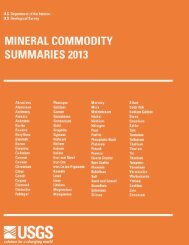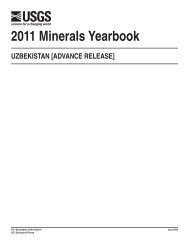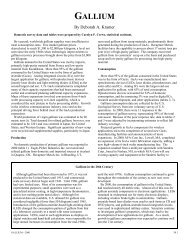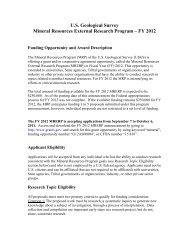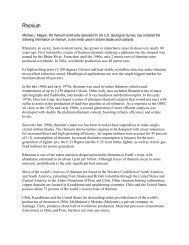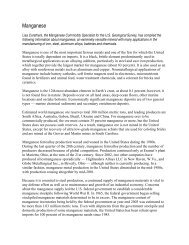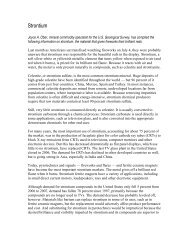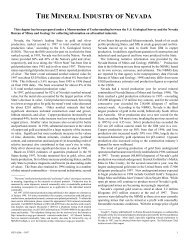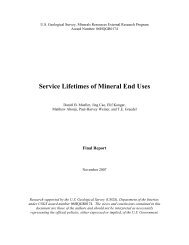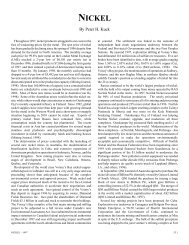Mineral Commodity Summaries 2003 - Mineral Resources Program ...
Mineral Commodity Summaries 2003 - Mineral Resources Program ...
Mineral Commodity Summaries 2003 - Mineral Resources Program ...
You also want an ePaper? Increase the reach of your titles
YUMPU automatically turns print PDFs into web optimized ePapers that Google loves.
Government Stockpile:<br />
DIAMOND (INDUSTRIAL)<br />
Stockpile Status—9-30-02 5<br />
Uncommitted Committed Authorized Disposal plan Disposals<br />
Material inventory inventory for disposal FY 2002 FY 2002<br />
Industrial stones 0.797 0.219 0.797 1.300 0.412<br />
Events, Trends, and Issues: The United States will continue to be the world’s largest market for industrial diamond<br />
into the next decade and will remain a significant producer and exporter of industrial diamond as well. Increase in U.S.<br />
demand for industrial diamond is likely to continue in the construction sector as the United States builds and repairs<br />
the Nation’s highway system. Industrial diamond coats the cutting edge of saws used to cut cement in highway<br />
construction and repair work.<br />
World and U.S. demand for diamond grit and powder will grow during the next 5 years. Increases in demand for<br />
synthetic grit and powder are expected to be greater than for natural diamond material. Constant-dollar prices of<br />
synthetic diamond products probably will continue to decline as production technology becomes more cost effective;<br />
the decline is even more likely if competition from low-cost producers in China and Russia increases.<br />
World Mine Production, Reserves, and Reserve Base: 6<br />
Mine production Reserves 7<br />
Reserve base 7<br />
2001 2002 e<br />
United States ( 2 ) — NA NA<br />
Australia 13.1 13.1 90 230<br />
Botswana 5.1 5.1 130 200<br />
China 1.0 1.0 10 20<br />
Congo (Kinshasa) 9.1 9.1 150 350<br />
Russia 11.6 11.9 40 65<br />
South Africa 6.7 6.7 70 150<br />
Other countries 1.4 2.0 85 210<br />
World total (may be rounded) 48.0 48.9 580 1,200<br />
World <strong>Resources</strong>: Natural diamond resources have been discovered in more than 35 countries. Nevertheless,<br />
natural diamond accounts for less than 10% of all industrial diamond used; synthetic diamond accounts for the<br />
remainder. At least 15 countries have the technology to produce synthetic diamond.<br />
Substitutes: Materials that can compete with industrial diamond in some applications include manufactured<br />
abrasives, such as cubic boron nitride, fused aluminum oxide, and silicon carbide. Synthetic diamond rather than<br />
natural diamond is used for more than 90% of industrial applications.<br />
e<br />
Estimated. NA Not available. — Zero.<br />
1<br />
Reexports no longer are combined with exports because increasing amounts of U.S. reexports obscure apparent consumption rates.<br />
2<br />
Less than ½ unit.<br />
3<br />
Defined as imports - exports + adjustments for Government and industry stock changes.<br />
4<br />
May include synthetic miners’ diamond.<br />
5<br />
See Appendix B for definitions.<br />
6<br />
Natural industrial diamond only. Note, however, that synthetic diamond production far exceeds natural industrial diamond output. Worldwide<br />
production of manufactured industrial diamond totaled at least 614 million carats in 2001; the largest producers included Ireland, Japan, Russia,<br />
and the United States.<br />
7<br />
See Appendix C for definitions.<br />
U.S. Geological Survey, <strong>Mineral</strong> <strong>Commodity</strong> <strong>Summaries</strong>, January <strong>2003</strong><br />
59



